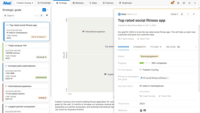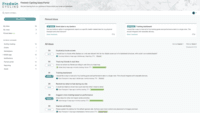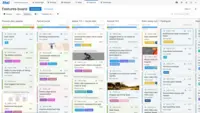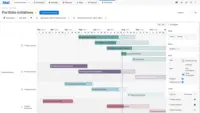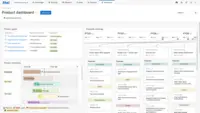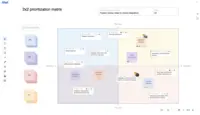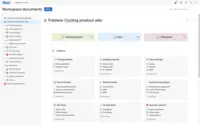Overview
What is Aha! Roadmaps?
Aha! Roadmaps is used to set strategy, prioritize features, and share visual plans. It includes Aha! Ideas Essentials for crowdsourcing feedback. For an integrated product development approach, Aha! Roadmaps and Aha! Develop can be used together. The software is available…
I won't manage a product without Aha!
Great way to manage and prioritize all things software related in one place
Love using this product
Aha! delivers on the promise of product roadmapping in agile software product management
Great play for the Product Management market
Aha! for all your roadmapping needs
Aha! has helping our product team thrive in 2020 and beyond!
Aha is the penultimate product planning tool
Excellent tool for small companies!
Aha! - One of the best Product Roadmapping software
Aha! - Strategy tracked how you need it
An excellent tool for realizing your strategic vision
Aha! is a great tool for high level strategic planning and idea bank management - not so much for day-to-day execution.
The kitchen sink of product management tools ... that needs a little work
Worth the learning curve
Pricing
Premium
$59
Enterprise
$99
Enterprise+
$149
Entry-level set up fee?
- Setup fee optional
Offerings
- Free Trial
- Free/Freemium Version
- Premium Consulting/Integration Services
Product Details
- About
- Integrations
- Competitors
- Tech Details
- FAQs
What is Aha! Roadmaps?
Aha! Roadmaps Features
- Supported: Goals can be set and linked through to key features, and the product roadmap.
- Supported: Each product feature can be assigned a product value score based on goals to prioritize what will deliver the most impact.
- Supported: Can be used to monitor progress status and communicate updates.
- Supported: Provides interactive roadmap presentations.
- Supported: Generates visualizations from entering data once.
- Supported: Captures feedback from customers, colleagues and partners via a custom-branded portal. Ideas and be ranked on value and effort, and promoted to the product roadmap.
- Supported: Plan visualizations displays the timing and scope of critical initiatives, launches, and projects, ensuring the capacity, deliverables, and dependencies can be seen across teams.
Aha! Roadmaps Screenshots
Aha! Roadmaps Integrations
Aha! Roadmaps Competitors
Aha! Roadmaps Technical Details
| Deployment Types | Software as a Service (SaaS), Cloud, or Web-Based |
|---|---|
| Operating Systems | Unspecified |
| Mobile Application | Apple iOS, Android |
Frequently Asked Questions
Comparisons
Compare with
Reviews and Ratings
(103)Community Insights
- Business Problems Solved
- Pros
- Cons
- Recommendations
Aha! Roadmaps is widely used by product management, engineering, and management teams for managing the product backlog and roadmap. The software's integration with other tools like Jira, Azure Dev Ops, Microsoft Teams, and Mavenlink project management enables seamless collaboration among different teams. Users appreciate the ideas portal feature in Aha! as it allows customers to enter and vote on ideas, guiding the development process to meet business needs effectively. With its ease of use in collecting and organizing features, Aha! simplifies the process for product managers, who find the learning curve for basic features quite straightforward.
The tool is particularly valued by product management teams for visualizing product roadmaps and managing dependencies efficiently. Its integration with Jira facilitates easy task tracking and updates, streamlining workflows for non-technical marketing teams. Aha! provides various helpful features such as visual orientation, internal linking capabilities, Gantt charts, and timeline mapping that aid in better planning and organization. By enabling users to track upcoming and current work across multiple teams within the entire organization, Aha! addresses the business problem of coordinating and managing efforts effectively. It allows product managers to associate each feature with its value to the organization and customers, setting it apart from other similar tools in the market. Additionally, Aha! serves as a platform for documenting product strategy, prioritizing initiatives, creating and tracking roadmaps, and communicating outcomes to engineering teams. IT and code-related functions also utilize Aha! to manage software releases, bug fixes, and ticket requests seamlessly.
Comprehensive Product Management Suite: Many users have found Aha! Roadmaps to be a comprehensive product management suite that excels in breaking down product plans into initiatives, features, and user stories. This feature helps the organization understand the product plan and the driving factors behind individual work items.
Effective Prioritization: Aha! stands out from project management tools like Jira by providing prioritization based on major themes, features, and releases. Users appreciate this feature as it allows them to organize and prioritize features effectively, making it difficult to go back to a traditional project management tool.
Idea Management Portal: Aha! is particularly useful for idea management. It offers a portal for users to submit ideas and manage them through a workflow. Some users appreciate that ideas can be submitted through various channels, including email, ZenDesk, and SalesForce. The ability to attach account values to ideas submitted through SalesForce is also appreciated.
Difficulty with Jira Mapping: Users have reported difficulties mapping products to projects in Jira, especially for engineering teams working on multiple products. This issue has been mentioned by several reviewers and affects the seamless integration between Aha! Roadmaps and Jira.
Overvalued Idea Management Feature: Some users feel that the idea management feature is overvalued and unnecessary for many companies, requiring a large product management team and excess development capacity. This sentiment has been expressed by multiple reviewers who believe that this feature adds complexity without providing significant value.
Missing Capacity Planning Feature: The lack of a robust capacity planning feature is considered a major drawback. Several reviewers have stated that the current capabilities are only half-functional, requiring manual entry and lacking easy feedback and progress tracking. This limitation hinders effective resource allocation and project planning within Aha! Roadmaps.
Based on user reviews, here are the three most common recommendations for the software:
-
It is important to have a strong governance process before implementing the software. Take the time to understand its functions and customize it to fit your business.
-
The software is a comprehensive tool for managing products throughout their lifecycle. Fully evaluate it before making a judgment on its usefulness. It can be particularly beneficial for commercial financing aids, sales communication progress, marketing project management, strategy adjustment, and goal setting.
-
Take advantage of integrations with other tools like Jira, but be prepared for some customizations not mapping perfectly. Make use of the free trial and support offered by the software. Be ready for a steep learning curve initially, as the software has many useful features like roadmaps and data analysis.
Overall, users recommend using this software to centralize product planning and roadmapping work, make informed decisions, keep stakeholders informed, and efficiently manage projects in an enterprise-level environment.
Attribute Ratings
Reviews
(1-6 of 6)- Building a roadmap
- Feature request board
- Collecting competitive intel
- Aha! is a little expensive
Excellent tool for small companies!
- Excellent organization, because it allows us to filter by status and category
- Easy enough to keep track of my own submitted ideas and items I've voted on
- Beautiful comment threads to see everyone's thoughts
- Great notification system to see what's changed and how, so I don't have to live and breathe Aha!
- I wish the notifications could be streamlined, so that the text of the email was just simpler and easier on the eyes, and that I could respond to comments by replying to the email instead of opening up Aha! again.
- A little more color wouldn't hurt. The UX is smooth, but the design is rather bland. It still gets the job done though.
Aha! - One of the best Product Roadmapping software
- Product road-mapping is best in Aha!
- The types of boards it has gives flexibility to every kind of product managers.
- It has various matrices to make the foundation for a good PRD.
- Bug tracking needs to be improvised, JIRA has upper hand in this.
- Notes section can be improved as we found less flexibility in Notes.
- The integration of Tech team to use Aha! needs to be strengthened. As of now, Tech is reliable on project tracking software rather than Aha!
- Provides an easy to understand visual for upcoming releases and what is included.
- Makes it easy for Product Managers to interact directly with users via the Idea Bank portal.
- Provides a way to link dependencies and related features to help understand expected feature releases.
- Policing the idea bank to make sure ideas are specific and representative of a single idea is a manual task.
- There are a lot of times when I save and close an item and it just disappears from my current view. This is usually due to user error, it just seems too easy to make those errors all too often. I wish I was warned if I'm about to save (or close) a record that is going to disappear from my current view.
- I wish there was easy to find, approachable training material to teach me how to use parts of the system that I don't even look at today (such as Personnas)
- I love the ideas list. If we have repeating ideas it's easy to prioritize them to our road map.
- I created and used the competitors list to really break down how we compare against other companies.
- Releases shows a clean overview of our product road map.
- When I first started using Aha! I was quite overwhelmed with all of the features. This may be due to user error, but I would have liked more guidance through each step.
Aha! - The All-Around Product Management Suite
- Aha! is an all around product management suite. It is great for breaking product plans into initiatives, features, and user stories. This helps the organization understand the product plan and what is driving individual work items. Unlike JIRA and project management tools, it helps you prioritize by major themes, features, and releases. Once you start to use it, you can't go back to a project management tool because the views for organizing and prioritizing features just isn't there.
- Aha! also excels at idea management. You can create a portal for users to submit ideas and manage them through a workflow. Users can submit ideas through a variety of channels, including email, ZenDesk, and Salesforce. You can even attach account values to an idea submitted through Salesforce, though the UI in Salesforce is a little kludgy. This is a great feature for those that have the capacity to manage feedback this way, but be aware that it takes time to manage.
- Aha! works pretty well with JIRA so that project managers can have their backlog that is understandable to the business and engineering can break down those work items however they want.
- Aha! also has a lot of useful integrations: Slack, ZenDesk, Zapier, etc. It also integrates with every major software project management tool on the market: JIRA, Pivotal, Rally, Redmine, and TFS.
- There are a few catches once you get down to using it. For example, Aha! maps products to projects as a one-to-one in JIRA. Why should anyone care? If your Engineering team is organized into functional groups that work on more than one product, this can be a mess. You can't send features to two different teams for one product. Other products like Wizeline support this.
- Idea management can be overvalued. Be sure you need it before you make it a must-have feature. Idea management is great for enterprise B2B companies with a small base of users to support and the development capacity to be responsive to ad hoc feedback. Think a closed beta participant group, a CAB or small disciplined internal user group like Customer Success. However, it takes a large PM team and excess capacity in Development to manage this sort of feedback. Otherwise, you set yourself up for failure. Look at Aha!'s own idea portal, and you can see it takes a large PM team to track everything, and even then, the user community has to accept that there isn't going to be an immediate response the way a service desk would respond to a problem ticket. If this functionality is not key, there are other tools like User Voice that can be purchased separately later to provide best of breed feedback management.
- Capacity Planning is a major missing feature. Aha! has half functional capacity planning. It requires manual entry and does not support easy bottom up feedback and progress tracking from the dev team working in JIRA. My team found that it was not usable enough to show what was above or below the line on the fly. This is very disempowering for Product Managers who 'want their mojo back' as Aha!'s marketing says. There is a huge discussion in the Aha! user community about this. Even Brian and Chris have responded, so they are looking at it. It's hard to lead management discussions about what to do when resource tradeoffs on what is above or below the line are not clear. This has been one of the most requested features that is still not there after a year of users clamoring for it...
- The Salesforce integration is not as useful as we thought. My Sales Team found it unusable because of kludgy UI issues. Also, it was hard for users to pile on with other accounts needing the feature, so it only represented one ask from one account, not the market. Plus, it can be totally random which sales person speaks up, leading to a squeaky wheel effect. We found it easier to run this kind of analysis through our web analytics tool, Woopra. Any major account requests were just handled the old fashioned way.
- We did not use the strategy or roadmap screens as much. We really just needed a wiki to store this info. Old fashioned PowerPoint and tools like Product Plan can cover this as an alternative. Our core usage centered around the initiatives, the product backlog screen, and the reporting (for the roadmap as opposed to the actual roadmap page).
- Aha! is the all around product management tool. You need something once you build out a product management role and grow beyond a small scrum team with one or two products. JIRA, Pivotal, and project management tools don't cut it for aligning [engineering] with product initiatives once the backlog starts to scale.
- On the other hand, there are several unfinished features that my peers all admit to having to work around: Capacity Planning, Salesforce Integration, Roadmap Display Flexibility, User Feedback, etc. This year has been all about reporting in terms of feature releases. As Aha! grows, they will fill in these other areas, so stay tuned.

